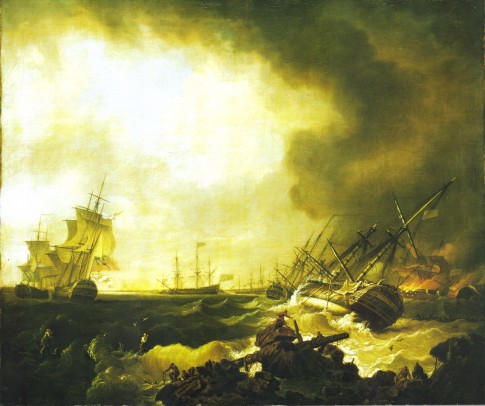THE BATTLE OF QUIBERON BAY, 21 NOVEMBER 1759: THE DAY AFTER
By Richard Wright, 1760
(Highest resolution available 5397×4519)
With considerable expense and effort the blockading British fleet commanded by Admiral Edward Hawke (1705-1781) remained healthy. The French had not left Brest for three full years. Their courageous commander Comte de Conflans could not bear such idleness any longer. He devised a plan of attacking a small British squadron blockading the transports at Morbihan and got a permission to execute it. On November 14th as Hawke’s ships were blown off station by the foul weather, the French fleet escaped the blockade and left Brest. Hawke chased and caught up with it by the sunset. Surprised to see Hawke approaching Comte de Conflans sought shelter in Quiberon Bay, which was guarded by uncharted rocks and hidden shoals. There he believed Hawke would not follow him given the stormy weather and night coming. Hawke, however, did not want to miss the French again and followed their every move.
A chaotic and fierce engagement began. In heavy seas ships rolled, pitched and heaved in the swell so that there was real danger of flooding through the gunports. The biggest ships had 50 such two foot square holes on each side with the lowest only three feet above the waterline. Therefore, it did not take much of a swell or a particularly strong wind to endanger the ship. In the middle of the battle a strong gust of wind blew the French 74-gun Thésée flat. Water poured into her gunports and she sank with appalling loss of life. Not long after, the French 70-gun Superbe sank after only two broadside from Hawke’s flagship, an extremely unusual occurrence as gunfire rarely caused a ship to sink. All 800 of her men were lost and more carnage followed in the aftermath of the battle, the subject of this painting. Two French ships were driven ashore and burned, two more were wrecked. Two British ships were also wrecked, but their crews saved. The British Resolution lies wrecked in the foreground, the captured French Formidable is shown with a British ship to the left. Conflans’s ship the Soleil-Royale, and the French Héros burn in the background. Hawke’s ship, the 100-gun Royal George, lies broadside-to at anchor in the centre on the painting. The French lost six ships and 2500 men in the battle. Their plans for invasion were abandoned.
